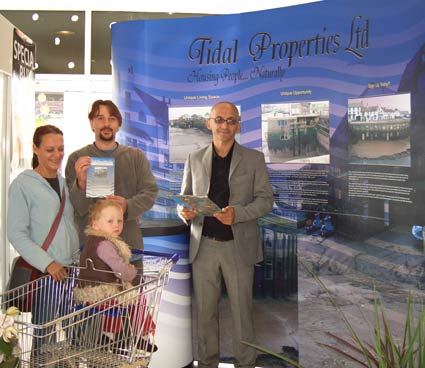William Titley










Further Information:
It would seem that we all know how to spot a sales pitch when we see one and the commodity of regeneration is no exception.
Regeneration is now commonplace in every British town and city today. Redevelopers are forever on our doorsteps selling us new homes or new lifestyles, to get us out of what we already have, know and probably like.
For the company ‘Tidal Properties Ltd’ to put up a mobile exhibition stand for one week in the Co-op supermarket in Maryport then, was not an unusual event for local residents. The set up was recognisable; a well dressed, amiable sales person, colour display boards, leaflets and information are all recognisable traits to engage people in the process of selling the latest development.
However as much as the sales person was telling you this development was different, it really was this time, as it was a project by William Titley and Tidal Properties Ltd and its property were all part of an elaborate artwork.
Regeneration for Maryport harbour in reality has already been planned. Tidal Properties’ product was the supposed redevelopment of Waterside, a once thriving fishing village on the harbour side. The unique properties for sale are the recently excavated fisherman homes, embedded within the harbour wall itself.
The ‘history’ of these properties was constructed from the work of the pioneering fictional architect Albert Gunn (All But Gone) who built the apartments with sophisticated waterproofing and dehumidifiers. With it, a social history was also constructed to give further life to the tale, painting a picture of local economies and communities thriving and then declining due to industrialisation and pollution.
The accompanying text was a key component to convincing people that the development was real; the context and language itself was easily transferable between fact and fiction.

The rational mind tells you that to live in the dock wall would be a ludicrous notion, however the images produced by William are very convincing, people were initially taken in by them. The merging of housing in the dock wall is a merging of realities: the housing stock (windows, doors etc.) is taken from a previous project by William, which looked at the condemned homes through housing market renewal from Bright Street in Colne, Lancashire.
With the Bright Street project, William was predominately looking at demolition and with Tidal Properties it is about redevelopment. How Bright Street informed Tidal Properties is significant, the real life issues faced by people going through re-housing in the name of regeneration was played upon in developing the language and tone of Tidal Properties. This way, William got to play on both sides of the fence in terms of demolition and redevelopment.
The communication between William and the public inquiring about the development was an important element to the project. The eschewed discussions raised debates and conversations, for some members of the public the threat of change raised memories of how the place used to be, for others it made them see the harbour in a completely different way.
This provocation was essential to how the project was understood and how the salient ideas were transferred from concept to a basis of a real debate that engaged with the realities that exist in redevelopment. In these consumer times if packaged right almost anything is sellable.
Kerenza Hines. Public Art Curator.
Back to Tidal Properties Ltd Main Page.